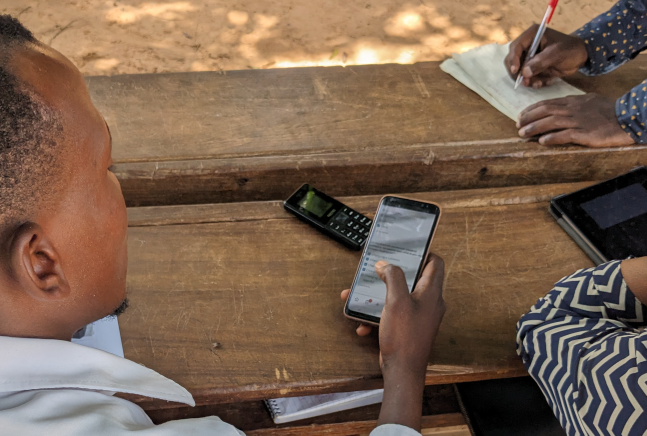Home » Our Topic Areas for Evidence » Evaluating Cost-Effectiveness in EdTech
Cost-effectiveness for EdTech
BRIDGING THE GLOBAL EVIDENCE GAP

Fast facts
- The challenge
- Our role
- Activities
Enthusiasm for using technology in education, plus an associated lack of accountability for spending on technology, means that for a long time, resources have been invested without addressing the inconsistency of measurement of both cost and effectiveness. There remains a big gap between investments in technology and a demonstration of what effects that spending has on learning outcomes.
Addressing the learning crisis requires championing systems that are cost-effective when it comes to the use of EdTech for learning. EdTech Hub tackles the lack of harmonised data on costs and learning outcomes, promotes robust analysis tools, and inspires evidence-based decision-making.
By equipping stakeholders with the tools and knowledge for transparent evaluations, EdTech Hub empowers them to make informed EdTech investments that improve learning outcomes for children in low-income contexts.
- Consolidating useful, pre-existing evidence on cost-effectiveness analysis in education and in EdTech.
- Conducting cost-effectiveness analysis across the EdTech Hub research portfolio.
- Engaging in public dialogue with the sector experts on cost-effectiveness; including Brookings.
Explore more
You can explore all EdTech Hub’s publications on Cost-Effectiveness for EdTech in our curated list below, or you can refer to our Evidence Library.
This interactive map displays cost data from EdTech Hub studies and other research, organised by location. Go to the map.
Explore videos, webinar recordings, soundbites, and more related to cost-effectiveness and Learning Adjusted Years of Schooling (LAYS).
About cost-effectiveness for EdTech ➜
Cost-effectiveness matters because it is the foundation for decision-making in EdTech, but the necessary data is not currently being collected. Cost data is not collected in a way that it can be linked to learning outcomes. Neither costs nor learning outcomes are captured in a harmonised way which facilitates comparison. Without being able to compare the costs and effectiveness (in terms of learning outcomes) of education interventions, it is difficult for decision-makers of all kinds to choose between the many EdTech products available. Without evidence regarding cost and effectiveness, investments in EdTech remain overly speculative.
Join us in bridging the evidence gap. Read on for resources, research, and tools to support your work.
The change EdTech Hub wants to see ➜
Addressing the global learning crisis requires a fundamental change in how technology is used in education. A central problem limiting the current impact of EdTech in low-income countries is the lack of consistent focus on cost-effectiveness. While there is much talk about impact and cost analysis, there is no agreed approach to assessing cost-effectiveness in a way that reflects the complexity of different contexts while also being able to provide a robust comparison tool for the sector. This means that inappropriate EdTech is promoted, vendors do not thrive, poor decisions are made, which wastes limited resources, and children do not learn as they could.
EdTech Hub seeks to be at the forefront of efforts to address this problem and achieve a significant change in practice, inspiring and equipping the sector to engage with transparent and robust cost-effectiveness analysis as the new-normal in EdTech.
“The global learning crisis is real. Millions of children are in school but are not actually learning. To fix this, we do not just need to spend more—we need to spend more effectively and in ways that truly matter. By using cost-effectiveness analysis or LAYS, we can ensure that every dollar spent and invested leads to real learning gains.” – Neema Jayasinghe, EdTech Hub
Essentials for cost-effective EdTech planning ➜
Different stakeholders approach EdTech cost-effectiveness with different goals and assumptions, which can create confusion. To improve practice, you need clear, shared terminology and methodology. Focus on:
- Agreed measures – to identify and consolidate a set of common metrics for measuring cost and learning outcomes.
- Comparable data – gathering cost-effectiveness data with that common set of metrics, providing an evidence base of comparable data, alongside other existing cost-effectiveness data.
- Repeatable methods – defining the elements of specific classes of EdTech interventions that have demonstrated consistent outcomes at different costs, to shape benchmarks EdTech planning.
Reliable data is key to tackling the under-reporting of implementation costs, which is especially common in EdTech. Technology vendors often use pricing models that tie governments and schools to proprietary systems, leading to hidden long-term costs. Weak feedback loops mean students, teachers and parents have little say in decisions about hardware, software and infrastructure, even though they are the main users. Implementation costs also often ignore external factors and staffing expenses, making projects seem cheaper than they really are, especially when scaling up. Accurate data is essential for making informed and sustainable EdTech investments.
Reliable data is essential to accurately compare costs and learning outcomes across different countries and contexts. In many low- and middle-income countries, existing data is often unreliable, based on standardised tests that are inconsistently designed and not nationally representative. Cost data is also incomplete, typically reflecting donor expenditure rather than the true costs of implementation. Improving the reliability of data is crucial for making informed decisions, ensuring fair comparisons, and enabling effective replication of successful projects.
Donors, governments and implementers often have different priorities for comparing cost-effectiveness, leading to inconsistencies in data collection and analysis. A donor working across multiple countries may focus on comparing the cost-effectiveness of their overall expenditure, while a ministry of education may prioritise comparing different interventions within their own country. Without proactive planning, these figures will not align, making comparisons unreliable and potentially misleading. Ensuring a shared approach to data design is key to producing meaningful and accurate cost-effectiveness assessments.







December, 2024
This blog features an independent review of a tool we found particularly useful. We’re sharing it in the hope that you’ll find it just as valuable for your own work.
December, 2024
This blog features an independent review of a tool we found particularly useful. We’re sharing it in the hope that you’ll find it just as valuable for your own work.
June, 2024
This Learning Brief explores the question, "How can decision-makers assess EdTech interventions for cost-effectiveness to enable better investments?" It explains why this question matters, provides insights for effective decision-making, and highlights areas that require further work—all based on practical evidence from EdTech Hub and across the sector.
November, 2021
The challenges of school closures over the past year, and potential of EdTech to address them, are currently amplifying questions about the value of EdTech at a global scale. While ‘What is cost-effective EdTech?’ is a simple question, the answer is highly nuanced, given dependency on the initiative design, implementation, audience, context and time frame. This blog highlights the findings of an EdTech Hub brief that provides key considerations and case studies that can support decision-makers in answering this question.
September, 2024
This blog explores how nudge messaging impacts education in West Africa, sharing both successes and challenges. Through Wunni Sabo’s story, it examines how these nudge messaging has the potential to influence parents and students and asks the question: Are these interventions in West Africa genuinely cost-effective, or are they merely a low-cost form of EdTech with limited impact on learning outcomes?
September, 2022
This report is the first in a three-part series by EdTech Hub on cost-effectiveness analysis for EdTech interventions in low- and middle-income countries. It provides an overview of cost-effectiveness analysis, explores approaches used by other education sector stakeholders, and offers essential context for understanding cost-effectiveness in EdTech.
March, 2024
This blog explores how EdTech Hub is driving a global movement for an evidence-driven future in EdTech.
Resources on cost-effectiveness
Background research on cost-effectiveness
Cost-effectiveness analysis in EdTech Hub research and beyond
June, 2024 │ Learning Brief
How Can Decision-Makers Assess EdTech Interventions for Cost-Effectiveness to Enable Better Investments?
December, 2024 │ Blog
Tools for your toolbox: How to capture EdTech costs for smarter decisions
December, 2024 │ Blog
Tools for your toolbox: Collecting data for cost-effectiveness with the Brookings Childhood Cost Calculator
Global data on cost-effectiveness
Click on an area of the map with a blue icon to view cost data from EdTech Hub studies and other research. You can also expand the map to full screen by selecting the “view larger map” button in the top right-hand corner.
Videos, soundbites and more
Questions we get asked on EdTech for cost-effectiveness ➜
To assess EdTech interventions for cost-effectiveness, decision-makers should consider both the total cost and expected impact on education. This involves gathering the right data, using existing frameworks for cost and impact analysis, and comparing EdTech solutions to non-tech alternatives. It’s also important to assess affordability within the broader educational budget. For more detail, read the full EdTech Hub Learning Brief.
The EdTech Hub paper, titled ‘Cost-Effective EdTech Paper 1: A position piece on how the sector can make progress’, is one of three papers in a series. It highlights key practices, including comprehensive cost assessments and frameworks used by stakeholders like ministries of education and development organizations. You can check out the full paper here.

